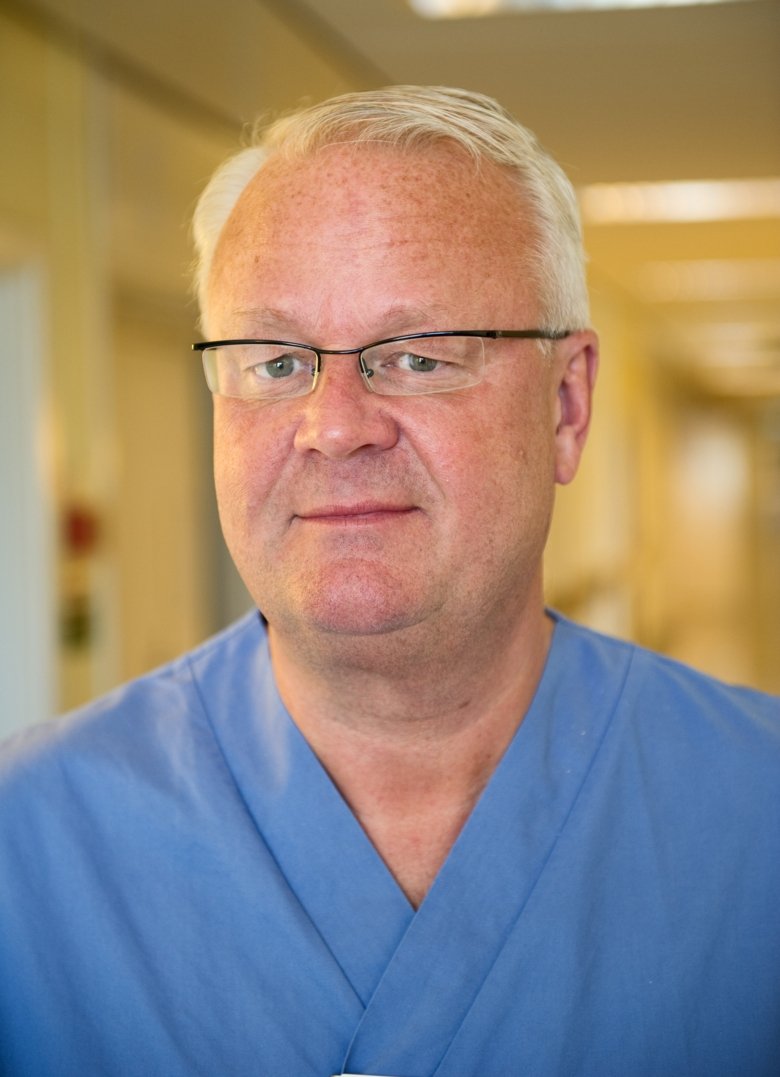Warning signals that run amok
Pain is a vital warning signal. But when things go wrong, it turns into a fire alarm that will not switch off even when the fire has long since been put out. Researchers are doing all they can to turn down the volume.

Text by Ola Danielsson, first published in Swedish in Medicinsk Vetenskap no 2, 2011. Some titles updated in June 2024.
In late 2007 researchers, drug company representatives and research funding bodies from across the USA gathered for an emergency summit in Colorado. All had invested time, money and energy in a common cause — understanding how pain arises and how it can be relieved. The agenda could be summed up in a single sentence: Where are we going wrong?
"Despite enormous effort, results in the form of new treatments for chronic pain haven't been as good as one might have hoped, so we decided to bring together every level of pain research to see how we could move things forward," says researcher and professor Camilla Svensson, who was then at the University of California but moved to Sweden soon after to begin research at Karolinska Institutet's Department of Physiology and Pharmacology.
Pain was originally seen as a simple warning signal from the body to the brain. Hit your thumb with a hammer and this stimulates pain receptors in the skin, a signal is sent to the brain, and it hurts. The natural reaction is to bandage the thumb, whereupon the pain subsides. But this picture does not tie in well with something like long-term joint pain, which is one of the most common pain conditions and Camilla Svenssons specialist field. Joint pain often starts when pain receptors are stimulated by inflammation, but even once all signs of the inflammation have gone, something often continues to cause pain - the question is what.
"The inflammation activates the pain nerves, and in some cases this eventually leads to something changing in the actual pain system so that the pain persists, and it's this change that we're trying to understand," says Camilla Svensson.
A number of relay stations
We now know that between the pain receptors and the brain are a number of relay stations which all affect the final perception of pain. Camilla Svensson's research focuses on the interplay between the inflammation in the joint and activity at the first relay station, where chemical messengers transmit the pain signal from the peripheral nerves to the neural pathways in the spinal cord.
She demonstrates this by brushing a thin nylon thread against the top of my hand. I can feel it, but obviously it doesn't hurt. This is because my pain nerves have a higher activation threshold than my other nerves — a stronger stimulus is needed for them to send signals to the brain. If I had chronic inflammation in my hand, as those with arthritis have in their joints, this pain threshold would be lowered, not only in the nerve endings in the hand but also in the relay stations in the spine.
This sensitisation is normally a good thing, because the increased tenderness and pain ensure that the person avoids using injured parts of the body, allowing them to heal in peace. But in some patients this inflammation leads to the volume in the pain system being cranked up out of all proportion — the slightest stimulus in a joint can trigger a pain impulse that is amplified many times en route to the brain and is experienced as severe pain.
In order to reduce the volume, researchers must first understand what happens when inflammation in a joint leads to sensitisation in the spinal cord, and why this hypersensitivity remains even after the inflammation subsides. By inducing rheumatic inflammation in mice, researchers are investigating how the pain threshold changes before, during and after inflammation — and why.
"One hypothesis is that the inflammation damages the nerve in a way that makes it stay hypersensitive, and perhaps no longer responsive to signals that would have normalised the threshold values after a short-term inflammation," Svensson explains.
But it is not just the nerves that are under the microscope in pain research. One of the hottest areas of research right now is the glial cells. These are best known as garbage collectors in the immune system, but recently more and more research groups have confirmed the unexpected discovery that they communicate with the pain nerves and actively help lower the pain threshold.
"This may be one of the reasons it's so hard to develop good painkillers. Pain research has focused almost entirely on the nerves — it wasn't known that completely different cells also play an important role," says Svensson, whose own contribution to glial research has been to show what role they play in long-term inflammation.
No known physical cause

Eva Kosek, a researcher and professor at the Department of Clinical Neuroscience, is looking into whether glial cells play the same role in the human body. Many of her patients suffer from chronic pain with no known physical cause. With luck, glial cells will offer a new way of turning the volume of pain signals down, if not off. But she explains that even if the pain signals make it through the spinal cord to the brain, it is still not necessarily too late, because signals then immediately rush back in the other direction, which affects the stream of incoming pain signals. In other words, the brain can regulate its own supply of pain. In healthy people this happens all the time without them even noticing, which is the whole point.
"There's a survival benefit in only feeling pain at the right times," she explains. "For example, normal physical labour generates many pain signals that the body neither wants nor needs to acknowledge."
Sometimes, though, the pain regulation system can instead amplify the pain, and even generate pain without any pain receptors in the body's tissues outside the central nervous system being stimulated. These pain-amplifying mechanisms have turned out to play a major role in long-term pain, and in many cases they are more important than the physical cause that originally triggered the pain - what started as a warning signal becomes a fire alarm that gets stuck on.
"In arthritis, for example, there is only a very weak relationship between how inflamed the joints are and how much they hurt," says Kosek.
Taken as a direct insult
Despite this, she still hears older colleagues saying "The X-rays are entirely normal, so it can't hurt" — a reasoning that research has shown to be wholly mistaken and can be expected to be taken as a direct insult by many patients. One patient group that has had to put up with considerable scepticism due to a lack of clear, physical, pathological changes is people with fibromyalgia, a condition characterised by pain and tenderness in large parts of the body.
"Studies using fMRI scanners have shown that the parts of the brain that help deal with pain are less active in people with fibromyalgia," says Kosek. "We believe that the cause of the disease is an imbalance in the body's pain regulation. The volume control is not working as it should."
Pain is not just problematic in itself but can have many negative side-effects such as sleep disturbances, loss of concentration, impaired memory, anxiety and depression. Patients' way of dealing with their pain has a major say in how much of a problem it is in their lives. One important part of pain management is learning not to be afraid of pain. Statistics show clearly that those who take time off work for back pain are less likely to recover than those who work on despite the pain. Keeping mobile — within reason — is the best thing for back pain, and physical exercise is now recommended as a treatment for rheumatic pain.

Research has shown that the mind plays an important role not only in how we deal with pain but also in how much it actually hurts. The placebo effect is very powerful when it comes to pain - even a completely inactive sugar pill can provide pain relief if the patient believes it to be an effective medicine. If, on the other hand, a patient expects a treatment to be painful, it generally will be more painful.
Predrag Petrovic, a researcher at the Department of Clinical Neuroscience, is trying to understand what happens in the brain when thoughts and emotions impact on depression and pain. He believes that the placebo effect is a logical consequence of the brain's way of working.
"The brain is constantly modelling the future," he explains. "What we experience is always a mixture of incoming signals from the body right now and the brain's picture of what will be happening subsequently."
The placebo effect
Back in the 1970s researchers showed that the placebo effect is down to a specific pain relief system in the body known as the opioid system. When we imagine being freed from pain, opioids are released in the body, and this results in a reduction in the pain signals to the brain.
If the opioid system is blocked, however, the mind loses its ability to influence pain — no opioids, no placebo effect. More recently it has been shown that opioid receptors are found in parts of the cerebral cortex that specialise in higher cognitive functions, which gives us a pointer towards how abstract things such as thoughts, expectations and attitudes can influence the body's pain regulation system.
By studying the brains of research subjects with PET scanners, Petrovic and other researchers have also managed to break down the experience of pain into its component parts.
"It's a bit like Lego," he says. "Pain consists of different components which are handled in very different parts of the brain before being put together into something that we perceive as a single thing."
The sensory perception of pain — that it hurts — is processed in one part of the brain. Another contributes the location of the pain — where it hurts. Finally there is an emotional component — the unpleasantness. Combining these components in different ways results in different types of pain.
"With what is known as abstract pain, there are no incoming pain signals from the body to the brain, but the pain system is still partially activated," says Petrovic. "This occurs, for example, when we see someone else hurting and feel their pain in sympathy," says Petrovic.
Research may eventually lead to new drugs for these different types of pain, but Petrovic believes that this knowledge can be applied more immediately to how we view pain. It is important for doctors to remember that the results of treatment for pain will be affected by the patient's expectations and confidence in the treatment, and that these in turn are influenced by the doctor's approach and way of presenting the treatment.
"This knowledge about the role of expectations bodes well for CBT-like treatments for pain," he says. "It's not a hush-hush thing – we can work quite openly with the patient´s expectations as an important factor in the treatment."
Many affected by neuropathic pain

It is easy to forget that pain is ultimately a valuable warning signal that something is wrong. People who lack the ability to feel pain, such as those with a hereditary disorder in part of northern Sweden, soon become incapacitated — for example by breaking bones without noticing. But there is also a kind of pain that has no survival value at all, and which the body struggles to regulate itself. This is neuropathic pain, which arises when the nervous system is damaged or diseased and begins to send wholly unnecessary pain signals to the brain. It is one of the most difficult types of pain to treat and can occur following injury or illness in both the peripheral and the central nervous system.
Per Hansson, professor of clinical pain research at the Department of Molecular Medicine and Surgery, has devoted his career to trying to understand and alleviate neuropathic pain. He explains that this pain can result from an operation or from diseases such as cancer, shingles, diabetes, stroke and spinal injuries.
A sixth of all diabetics — around 60,000 people in Sweden — suffer from pain as a result of nerve changes, mainly in the legs and feet. Some develop also allodynia, where they become hypersensitive to touch.
"This has a huge impact on their quality of life," says Hansson. "Even very gentle stimuli such as the blowing of the wind or the pressure of clothes against the body can be painful for these patients."
Nerve root pain
The most common form of neuropathic pain is probably nerve root pain, where a nerve root in the back is squeezed and damaged, perhaps as a result of a slipped disc or surgery for such an injury.
"Ordinary non-neuropathic back pain tends to come and go and is movement-related, but if the cause is damage to a nerve root, the pain is constant," says Hansson.
Nerve damage is often felt in a different part of the body to where it is actually located. This is because the brain always projects the pain to receptors in the nerve endings, even though the damage itself could be anywhere along the neural pathway or even within the brain itself. Nerve damage following amputation will often therefore result in phantom pains in the missing part of the arm or leg, and nerve root damage in the back can cause pain in the leg rather than in the back.
"We use a combination of classic neuroanatomical knowhow and the patient's history and test results to work out where the damage is located," says Hansson.
One treatment method used not infrequently at Karolinska University Hospital is spinal cord stimulation, where an electrical current stimulates the body's own pain-relieving neural pathways. There are no particularly effective drugs for neuropathic pain, but medicines developed for depression and epilepsy can help. The effect of antidepressants on pain has nothing to do with mood — researchers believe instead that the medicine directly supports the central nervous system's pain-inhibiting signals.
"We need better treatment methods, as we're unable to help around 60% of patients with their pain," says Per Hansson. "The problem with the medicines used is that they affect many different systems in the body and can therefore have significant side-effects. It's unclear to what extent these medicines actually act on the mechanisms specific to neuropathic pain."
Small channels opening
Every time a nerve sends a signal, it is the result of small channels opening in the cell wall through which electrically charged ions can flow. Researchers know that the expression of sodium channels is altered in damaged nerves which put out pain signals spontaneously, making them more easily irritated, but it is unclear how this knowledge can be used to attack neuropathic pain.

Tomas Hökfelt, professor of histology of the Department of Neuroscience, and his group may, however, be on the trail of the causes of neuropathic pain signalling. Together with Zsusanna Wiesenfeld-Hallin, professor of basic and clinical neurophysiology at the Department of Laboratory Medicine, he discovered many years ago that a chemical messenger called galanin is produced in large quantities in damaged nerve cells. The researchers were then able to demonstrate that galanin has a pain-relieving effect, while another group showed that it stimulates regrowth of damaged nerves.
"We believe that galanin is one of many components of the body's own defence against neuropathic pain," Hökfelt explains. "The reason why some people suffer from neuropathic pain may be that this defence has failed."
There was rejoicing in Tomas Hökfelt's laboratory when, using knowledge from experiments with galanin, researchers managed to block an enzyme in mice with the result that their pain threshold was dramatically increased for two whole days. No medicines have yet been able to achieve such an effect, either in animal models or in patients with severe pain. The next step is to investigate what role the enzyme in question, PLC, plays in the human body and whether something similar could be achieved there. Hökfelt hopes that this research will result in new drugs for neuropathic pain, but stresses that this is easier said than done.
"It's hard having mice as the basis for drug development. Time after time it turns out that the human body is different, and so we're now performing tests on human tissue to identify any differences and similarities between the pain system in humans and various rodents."
Particularly problematic
The use of laboratory animals in pain research is particularly problematic from a methodological point of view, as what is being studied is a subjective perception that quite simply cannot be measured. One common method of studying whether a mouse has a reduced pain threshold is to stimulate a paw with a thin filament and see whether the mouse pulls it away. However, Camilla Svensson prefers not to use the word pain when talking about animals.
"The only thing we can say for certain is that there is 'nociception'— the mouse pulls away its paw as a result of activity in pain nerves," she says. "We can never know for certain whether there is a perception of pain." And if there is, she adds, it is not certain that it is the same type of pain that is actually the problem in the conditions that researchers are trying to understand. Sudden pain is easiest to study, whereas low-grade aches and pains are possibly a greater problem for patients.
Svensson and many other pain researchers are now developing new experiments based on animals' natural behaviour and trying to capture the essence of clinical pain. One method is to measure how much mice move around spontaneously under different conditions. Researchers are also using preference tests where mice make various choices, such as spending more time on a surface of a certain temperature than on another, or whether to drink their pain medicine. Sometimes, though, the road from basic research to clinical application is unexpectedly short. At one point Camilla Svensson had a phone call from an American doctor asking questions about a TNF inhibitor which she had shown could help with neuropathic pain in rats.
"He works with soldiers with nerve damage from the Iraq war and had read my research articles and those of my colleagues. Now he wanted to try it out on his patients — and it turned out that it worked. It was fantastic that my 'rat research' could be applied so directly."
Long-term pain unlike short-term pain
With luck, this focus on new methods will reap rewards in the form of new painkilling drugs. But no "magic bullet" for all pain is in sight, and treatments need to be designed collaboratively by teams of doctors, psychologists, social workers and physiotherapists working together.
"Unfortunately the healthcare system has moved in the opposite direction, and many of the old pain clinics have closed," says Eva Kosek. "Many patients have nowhere to go."
This situation is particularly problematic because it is patients with long-term pain who suffer most from their pain. Kosek says that many of her patients live with pain that they describe as the worst imaginable. On a scale of one to 100, they put their pain at 100 — and some even higher.
"If you ask them to draw a comparison with the pain they felt when giving birth, for example, they say that it was different, that it was very intense but also positive, so they didn't really suffer. Their chronic pain, on the other hand, is harder to deal with because of the level of suffering."
Kosek believes that this is one of the big challenges for pain research. What is it that makes some pain cause great suffering, and how can we reduce this suffering? In a number of pioneering studies, researchers have begun to look at the differences between this long-term pain and more short-term pain in the brain. They have shown that brain activity connected with long-term pain is concentrated in parts of the brain that deal with cognitive functions and emotions, with hardly any activity in the parts involved in short-term pain perception.
"With chronic pain there's so much more going on than when you hit your hand, say, and as yet we understand very little about it," says Kosek.
One conclusion from the summit arranged by Camilla Svensson in the US was that pain research must continue to become more disease-specific.
"Pain has turned out to be more complex than anyone had imagined, and we're learning more and more about how each type of pain is unique," Svensson says. "We've been very good at using knowledge from other disciplines and have therefore been able to begin using treatments from other fields, such as antidepressant medication. With continued research, I think we will be able to develop more specific treatments for pain.
